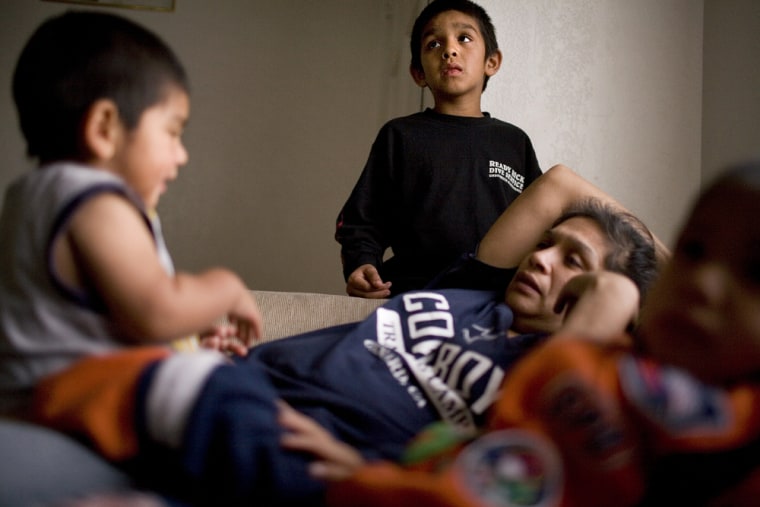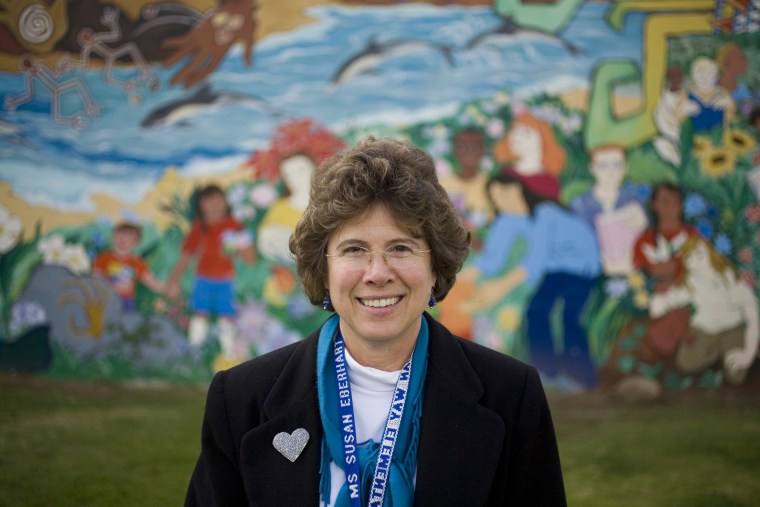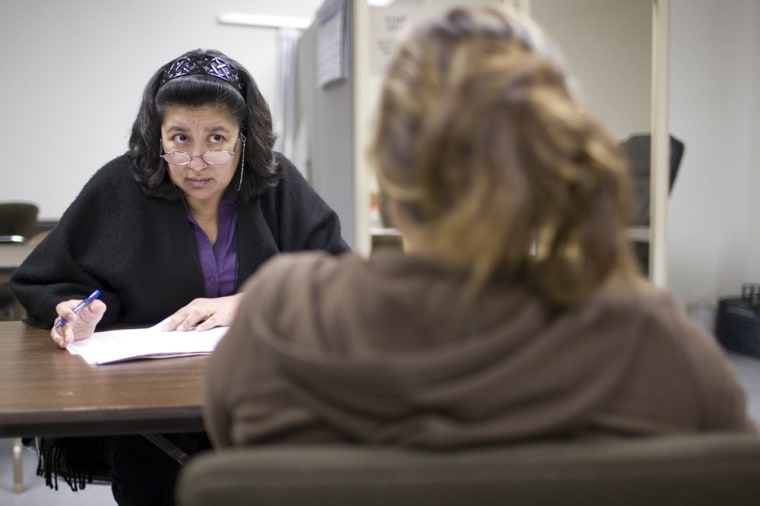Nine-year-old Daniel Valdez is absorbed in “The Swiss Family Robinson,” the fictional story of a family shipwrecked on a tropical island. In real life, he and his family also are marooned, but there is little romance in their tale of survival in this seaside town northwest of Los Angeles.
Daniel, his mother and five brothers, ages 1 to 17, livein a garage without heat or running water in a modest, low-lying neighborhood that sits between celebrity-owned mansions in the hills and the Pacific Ocean. Each morning, they arise at 6:30, get dressed and then leave quietly; they return only after dark — a routine born out of the fear that detection could mean the loss of even this humble dwelling.
Daniel and his brothers have been sleeping in the garage for more than a year — members of what school officials and youth advocates say is a rapidly growing legion of homeless youth.
While the problem may be worse in economically stricken regions like Southern California, where foreclosures and job losses are taking a harsh toll on families, anecdotal evidence suggests it is a growing issue nationally and one with serious ramifications for both a future generation and the overburdened public school system.
Research shows that the turmoil of homelessness often hinders children’s ability to socialize and learn. Many are plagued by hunger, exhaustion, abuse and insecurity. They have a hard time performing at grade level and are about 50 percent less likely to graduate from high school than their peers.
“Homeless children are confronted daily by extremely stressful and traumatic experiences that have profound effects on their cognitive development and ability to learn,” said Ellen Bassuk, a Harvard Medical School psychiatry professor and president of the nonprofit National Center on Family Homelessness. “They tend to have high rates of developmental delays, learning difficulties and emotional problems as a product of precarious living situations and extreme poverty.”
Mary Aguilar, Daniel’s mother, said she believes the family’s tenuous existence is largely responsible for her son's struggles with his third-grade lessons.
“He’s depressed a lot,” she said of Daniel, whom she says has been the most affected of her sons by the loss of their home. “He does his work for class, but very slowly, like he’s thinking. He worries a lot about living like this.”
Under federal law, schools are charged with keeping homeless students like Daniel from falling behind their peers academically. This can mean providing a wide range of services, including transportation, free lunches, immunizations and referrals to family services.
But with insufficient federal funding and budgets that are severely strained, many schools are struggling to meet the rising need.
‘It's like a tidal wave’

In Vista, Calif., about 35 miles north of San Diego, the population of homeless kids in the local school district reached 2,542 this year — about 9 percent of the student body and nearly 10 times the number just two years ago, said Rebecca Benner, the district’s homeless liaison.
“It’s like a tidal wave this school year,” she said.
Benner’s role as homeless liaison — only part of her job providing student services — is now full time, as she scrambles to register homeless students for free lunches, arrange for transportation, provide P.E. uniforms, line up counseling and cover SAT fees.
“It was supposed to be one small piece of my day,” she said. “… Now it’s almost insurmountable to get to the bottom of the phone messages.”
Hard-to-get numbersThe number of homeless people in the U.S. is the subject of much debate and disagreement. An annual one-night count, performed by social service organizations and volunteers who then report to the federal Department of Housing and Urban Development, attempts to tally the number of people living on the street, in cars or makeshift tents and in emergency shelters. The most recent survey — conducted in January 2008, before the full brunt of the recession hit — tallied 759,101 homeless Americans. Roughly 40 percent of them — or about 300,000 — were families with minor children, according to the survey.
Advocates for the homelesssay a more reliable picture of what is taking place comes through a separate count conducted in public schools, in which the definition of “homeless” is broader.
Under the McKinney-Vento Homeless Assistance Act, “homeless” includes not just children who live on the streets, but “any individual who lacks a fixed, regular and adequate nighttime residence.” In addition to those living in shelters or cars or sleeping on the street, that figure includes children whose families are doubled up with other families or living in trailers due to economic hardship, those who live in substandard housing and kids awaiting foster care placement.
In 2007-2008 — the last school year for which data is available — the nation’s 14,000 public school districts counted more than 780,000 homeless students, a 15 percent increase from the previous year.
“I think that was the beginning of seeing the foreclosure crisis impact,” said Barbara Duffield, policy director of the National Association for the Education of Homeless Children and Youth.

In a voluntary survey late last year by the association and another nonprofit, First Focus, 330 school districts reported that the number of homeless students appears to be far higher, said Duffield, co-author of a report on the survey published in December. She estimated that the number of homeless students is now close to 1 million — exceeding numbers in the period right after Hurricanes Katrina and Rita.
“It’s this year, 2008-2009, that the rug was pulled out from under many school districts,” she said.
Stimulus package to boost fundingFederal funding for schools to provide services for homeless kids is allocated throughMcKinney-Vento, a 1987 law that was bolstered by the No Child Left Behind legislation of 2002.
“Under McKinney-Vento, every district is required to have a liaison with the responsibility to identify homeless kids,” said Duffield. In addition to the staff, the school districts are responsible for providing a number of services, which can include everything from meals and clothing to athletic uniforms and educational field trips. One of the biggest costs in serving homeless kids is providing transportation to and from school, required even if the kids move out of the immediate area, she said.
The law included funding, but school districts must apply for grants to tap into it. Duffield estimated that only about 6 percent of the nation’s school districts received money through McKinney-Vento last year, though many more applied.
This year, schools were slated to receive $64 million to aid homeless students under the act. The newly passed federal stimulus package will add $70 million more in funding.
That will be a big help, Duffield said, while maintaining that the program “was woefully underfunded” even before the economic crisis pushed more people over the brink.
Duffield is now combing through the rest of the $787 billion economic stimulus package to see if funding in other categories might be used to help homeless students. For instance, the stimulus package includes $79 billion for a “State Fiscal Stabilization Fund” — about 80 percent of which is earmarked for K-12 education and is intended to offset state cuts in education funding.
The stimulus also adds $13 billion for Title I, the biggest federally funded education program, for schools that have large concentrations of needy students. Under some interpretations, these funds cannot be used to pay for transportation or liaisons for homeless students.
“(But) if the district identifies transportation, liaisons, social workers, gas cards, backpacks or shoes, they ought to be able to use their funds for that, because those are literally some of the needs,” Duffield said. “We’re looking for flexibility.”
Responses to the survey of school districts illustrate the variety of challenges that come with providing for homeless kids.
The Wisconsin Rapids Public School District, which serves 5,700 students in the state’s rural heart, counted 160 homeless students, a 50 percent increase over two years ago.
"One of the biggest challenges is transportation,” Heather Lisitza, the school district’s homeless liaison, was quoted as saying in the report. “Our city has only one taxi cab service and no public bus system. Another challenge (is)… we … have long, cold winters, all students need proper outerwear to go outside — snow boots, hat, mittens, snow pants and a winter jacket that has a working zipper or buttons on it. This expense adds up quickly and it is hard to provide to the increasing number of homeless students.”
More families pushed over the edgeSchool districts also say they are seeing more students from middle-class, working-class and working-poor families being pushed into homelessness.
Among them are Martin and Luz de la Rosa, who arrived one recent afternoon at the Ventura County (Calif.) Community Action Center, a facility that primarily serves chronically homeless men, for an appointment with a social worker.
The de la Rosas explained that they were seeking government assistance for the first time because they and their eight children — ages 3 to 16 — were just days from being evicted from their apartment.
Clutching a Bible, Luz de la Rosa said she lost her job at a small jewelry store as the recession kicked in. Then in November, her husband was laid off from the small Oxnard machine shop where he had been earning $19 an hour.
Martin said that left him with two untenable choices — continuing to collect unemployment benefits of $1,600 a month or taking a job at minimum wage, neither of which would cover rent for a home big enough for his family. The de la Rosas said they wouldn’t mind moving into a two-bedroom apartment, which is all they can afford here, but landlords won’t allow that many occupants.
Social worker Delores Suarez said she would like to place them somewhere together, but at the moment, there is simply not enough emergency housing available.
“They are probably going to end up split up among relatives” and attending different schools, she said.
Other homeless parents said that some schools are either unaware of their obligations to help or aren’t eager to provide the required services because of budget constraints.
Next in Suarez’s appointment book was a 35-year-old woman named Sylvia, who declined to provide her last name. She said that after a divorce three years ago, she lost her home to foreclosure and then couldn’t keep up with rent when she was laid off from her job at a car parts factory. She and her three kids then moved in with a friend.

“When the school found out we had moved (away from the neighborhood) … they wanted to remove the kids from school,” she said. Only after she met with district officials were they allowed to continue to attend, she said.
Identifying the homelessCompounding the problem of getting school districts to live up to their responsibilities is the fact that many homeless families are unwilling to acknowledge their living situation and therefore don’t receive services that could help them, said Susan Eberhart, principal of the Sheridan Way Elementary School in Ventura.
“People have to identify themselves as homeless (in order to get help), but that frequently doesn’t happen,” she said.
Eberhart said she and her staff are accustomed to kids who are struggling at home — nearly all of the school’s 514 K-5 students are poor enough to qualify for free breakfast and lunch. Although 86 of them were identified as homeless in the last survey, she guesses that, based on telltale signs, at least 100 meet the criteria.
“They have no place to keep stuff, so their backpacks are very full. Their clothes are not clean. They haven’t had a haircut, haven’t seen a dentist,” she said. “… Maybe a kid has asthma and is out of meds.”
Eberhart said she is swamped by the scope of the problem. She no longer has the assistance of a county social worker who used to handle much of the load — a budget cut caused the county to eliminate that resource. Now she is urging people to ask for help — and prodding community organizations to help fill the gaps as she identifies them.
“Some families are sort of floating, she said. “If we can get them to land, we can provide … continuity.”
While the stigma of homelessness prevents some from acknowledging their plight, others have more immediate concerns, said Beth McCullough, homeless liaison for the Adrian Public Schools in economically battered southeast Michigan.
Families with children living in emergency shelters, pop-up campers, cars and tents can be charged with neglect by Child Protective Services workers, and there have been instances where parents have lost custody, she said.
Fearing the loss of their kids, she said, "parents call in and say their kid won't be in school because they are going to Disneyland for a week, when the fact is that (they) don’t have a way to get them to school. Or parents will tell kids to lie about where they live."
Homework in pandemoniumFor Mary Aguilar, the Oxnard woman living with her kids in the garage — which she rents for $150 a month from a cousin — the assistance her kids might receive at school is not worth the risk that other children will ridicule them if their living arrangement becomes known.
So she tries to help them stay on track, though it’s a daily struggle. Daniel recently missed several days of school because of yet another cold — a common ailment, his mother said, because the garage has been especially cold this winter. Normally she walks three of her sons to their elementary school, but some days heavy rains have kept them home.
For now, the family has few prospects for better housing. The family became homeless after Aguilar's boyfriend, father to the two youngest boys, left about a year and a half ago, and Aguilar could not pay rent. When an opportunity came to sign up for emergency housing five months ago, she lined up at the courthouse before dawn. For that, she got her name on a waiting list of about two years.
She has applied for jobs in stores and fast-food restaurants and come up empty-handed. She is exploring a work rehab program offered by the state. Meantime, the family gets by on about $1,300 a month in food stamps and cash aid — but no child support from the boys’ fathers.
For now, the routine remains the same. After school, Aguilar and the six boys go to her mother’s apartment, where her brother and sister also live. Aguilar’s family can’t stay overnight — that would put the others at risk of eviction — but it is a place to eat and for the boys to study.
But Daniel’s 11-year-old brother, Isaac, said he’s sometimes too distracted by the pandemonium of 10 people and the television to do his homework.
“Then he tries to do it when we get back to the garage, but the light keeps everyone awake,” said Aguilar.
Isaac has fallen behind a grade, and Aguilar’s eldest son, 17-year-old Joshua, is attending a remedial program for drop-outs. Aguilar is pleased that Daniel has so far been able to keep up with his grade level.
Unaware of the tough odds he faces, Daniel says he plans to finish high school. Like other boys his age, he still has big dreams — of becoming a basketball star and working at something important someday.
But first and foremost, he dreams of “a very beautiful house … with a room of my own.” The walls would be decorated, he said, “with posters, and pictures that I have drawn, and tests that I did in school.”